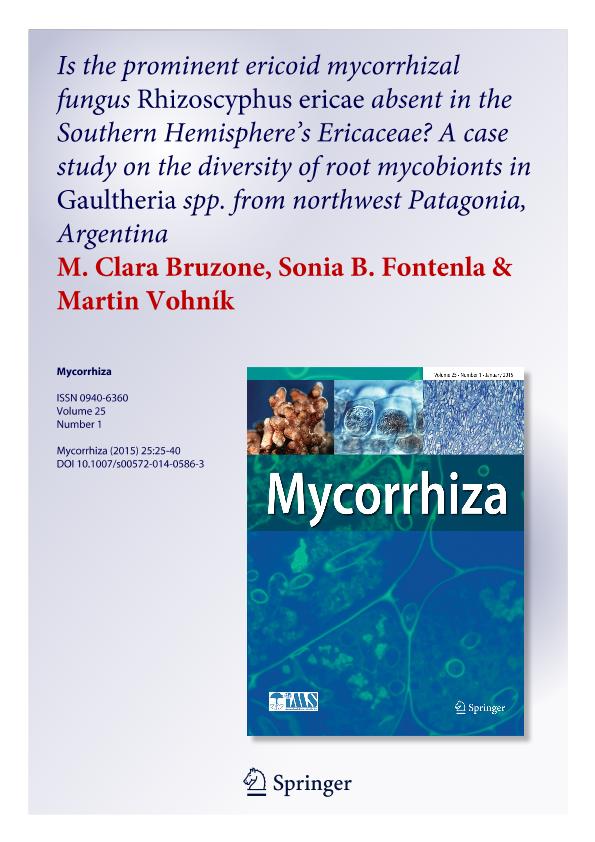Mostrar el registro sencillo del ítem
dc.contributor.author
Bruzone, María Clara

dc.contributor.author
Fontenla, Sonia

dc.contributor.author
Vohnik, Martin
dc.date.available
2018-01-09T18:45:34Z
dc.date.issued
2014-05
dc.identifier.citation
Vohnik, Martin; Fontenla, Sonia; Bruzone, María Clara; Is the prominent ericoid mycorrhizal fungus Rhizoscyphus ericae absent in the Southern Hemisphere’s Ericaceae? A case study on the diversity of root mycobionts in Gaultheria spp. from northwest Patagonia, Argentina; Springer; Mycorrhiza; 25; 1; 5-2014; 25-40
dc.identifier.issn
0940-6360
dc.identifier.uri
http://hdl.handle.net/11336/32692
dc.description.abstract
Ericaceae diversity hotspots are in the mountains of the Neotropics and Papua New Guinea, South Africa’s fynbos and Southeast Asia but majority of references to their root mycobionts come from the Northern Hemisphere. Here, typical cultivable ericoid mycorrhizal (ErM) fungi comprise Rhizoscyphus ericae, Meliniomyces variabilis, and Oidiodendron maius. It is however unclear whether this is true also for the Southern Hemisphere. Our study focused on cultivable mycobionts from hair roots of Gaultheria mucronata and Gaultheria poeppigii (Ericaceae) from two natural forests in NW Patagonia, Argentina, differing in mycorrhizal preferences of their tree dominants. We detected 62 well-defined OTUs mostly belonging to Helotiales and Hypocreales; the most frequent were Phialocephala fortinii s. l., Pochonia suchlasporia, and Ilyonectria radicicola. Only one out of 257 isolates showed ITS nrDNA similarity to members of the R. ericae aggregate (REA) but was not conspecific with R. ericae, and only five isolates were conspecific with O. maius. Microscopic observations showed that the screened roots were frequently colonized in a manner differing from the pattern typically produced by R. ericae and O. maius. A re-synthesis experiment with selected isolates showed that only O. maius formed colonization resembling ericoid mycorrhiza. Amplification of root fungal DNA with REA-specific and Sebacinaceae-specific primers showed that REA mycobionts were present in some of the screened samples while Sebacinaceae were present in all samples. These results suggest that Gaultheria spp. from NW Patagonia form ericoid mycorrhizae predominantly with the difficult-to-cultivate Sebacinaceae while the incidence of REA is relatively low and may be masked by other most likely non-mycorrhizal cultivable mycobionts.
dc.format
application/pdf
dc.language.iso
eng
dc.publisher
Springer

dc.rights
info:eu-repo/semantics/openAccess
dc.rights.uri
https://creativecommons.org/licenses/by-nc-sa/2.5/ar/
dc.subject
Ericoid Mycorrhiza
dc.subject
Root Endophyte
dc.subject
Phialocephala Fortinii
dc.subject
Sebacinaceae
dc.subject
Rhizoscyphus Ericae Ericae Specific Primers
dc.subject.classification
Otras Ciencias Biológicas

dc.subject.classification
Ciencias Biológicas

dc.subject.classification
CIENCIAS NATURALES Y EXACTAS

dc.title
Is the prominent ericoid mycorrhizal fungus Rhizoscyphus ericae absent in the Southern Hemisphere’s Ericaceae? A case study on the diversity of root mycobionts in Gaultheria spp. from northwest Patagonia, Argentina
dc.type
info:eu-repo/semantics/article
dc.type
info:ar-repo/semantics/artículo
dc.type
info:eu-repo/semantics/publishedVersion
dc.date.updated
2017-12-14T20:14:38Z
dc.identifier.eissn
1432-1890
dc.journal.volume
25
dc.journal.number
1
dc.journal.pagination
25-40
dc.journal.pais
Alemania

dc.journal.ciudad
Berlin
dc.description.fil
Fil: Bruzone, María Clara. Consejo Nacional de Investigaciones Científicas y Técnicas. Centro Científico Tecnológico Conicet - Patagonia Norte. Instituto de Investigaciones en Biodiversidad y Medioambiente. Universidad Nacional del Comahue. Centro Regional Universidad Bariloche. Instituto de Investigaciones en Biodiversidad y Medioambiente; Argentina
dc.description.fil
Fil: Fontenla, Sonia. Consejo Nacional de Investigaciones Científicas y Técnicas. Centro Científico Tecnológico Conicet - Patagonia Norte. Instituto de Investigaciones en Biodiversidad y Medioambiente. Universidad Nacional del Comahue. Centro Regional Universidad Bariloche. Instituto de Investigaciones en Biodiversidad y Medioambiente; Argentina
dc.description.fil
Fil: Vohnik, Martin. Charles University; República Checa
dc.journal.title
Mycorrhiza

dc.relation.alternativeid
info:eu-repo/semantics/altIdentifier/doi/http://dx.doi.org/10.1007/s00572-014-0586-3
dc.relation.alternativeid
info:eu-repo/semantics/altIdentifier/url/https://link.springer.com/article/10.1007%2Fs00572-014-0586-3
Archivos asociados
